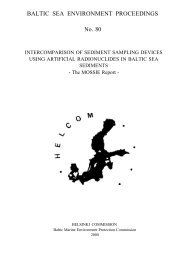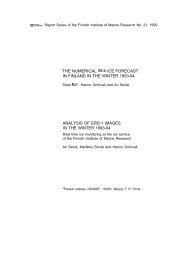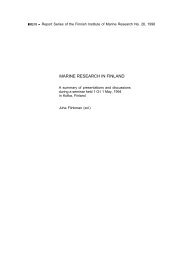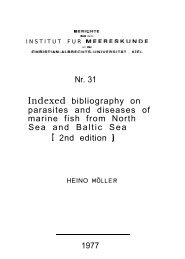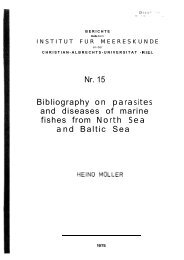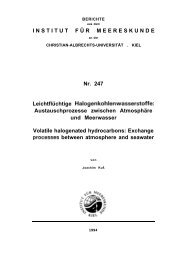Literature review on microbiology of aggregates or... - Baltic Marine ...
Literature review on microbiology of aggregates or... - Baltic Marine ...
Literature review on microbiology of aggregates or... - Baltic Marine ...
You also want an ePaper? Increase the reach of your titles
YUMPU automatically turns print PDFs into web optimized ePapers that Google loves.
38Hietanen Meri No. 37:37-44, 1998Aggregates are lost from the upper water layer by sedimentati<strong>on</strong>, which is enhanced by growing <strong>aggregates</strong>ize, and by grazing (Alldredge & Silver 1988). Grazing <strong>of</strong> <strong>aggregates</strong> by fish and zooplankt<strong>on</strong> hasrecently been proved to be an imp<strong>or</strong>tant sh<strong>or</strong>tcut in the food chain, transferring <strong>or</strong>ganic carb<strong>on</strong> to highertrophic levels m<strong>or</strong>e efficiently than via the microbial loop (Lampitt & al. 1993, Grossart & al. 1998).The relative imp<strong>or</strong>tance <strong>of</strong> these mechanisms in aggregate disappearance depends <strong>on</strong> the <strong>or</strong>igin and age <strong>of</strong>the <strong>aggregates</strong> (Biddanda & Pomeroy 1988, Riebesell 1991a, Turley 1992).2.1 Aggregati<strong>on</strong> and fate <strong>of</strong> diatom bloomA two-state coagulati<strong>on</strong> the<strong>or</strong>y, in which coagulati<strong>on</strong> is insignificant at low and significant at high algalc<strong>on</strong>centrati<strong>on</strong>s with a rapid transiti<strong>on</strong> between these two states, seems to adequately describe the dynamics<strong>of</strong> diatom blooms (Jacks<strong>on</strong> 1990, Riebesell 1991a, Kiørboe & al. 1994). At the beginning <strong>of</strong> thebloom there is no coagulati<strong>on</strong> <strong>of</strong> cells into <strong>aggregates</strong> neither is there any sinking <strong>of</strong> cells out <strong>of</strong> theeuphotic z<strong>on</strong>e. The c<strong>on</strong>centrati<strong>on</strong> <strong>of</strong> diatom cells increases rapidly until a critical limit is reached. Thecritical cell c<strong>on</strong>centrati<strong>on</strong> depends <strong>on</strong> cell sizes, cell surface “stickiness” and turbulence <strong>of</strong> water. At thecritical c<strong>on</strong>centrati<strong>on</strong> the cells aggregate, sometimes extremely quickly - the whole bloom aggregated andsedimented in 24 hours in the study <strong>of</strong> Alldredge & Gotschalk (1989). This pattern f<strong>or</strong> diatom bloomdynamics has also been rep<strong>or</strong>ted from the <strong>Baltic</strong> Sea spring bloom - an initial intensive bloom followedby rapid sedimentati<strong>on</strong> as a result <strong>of</strong> nutrient depleti<strong>on</strong> (Leppänen 1988, Leppänen & K<strong>on</strong><strong>on</strong>en 1988,Kuparinen & al. 1996, Kankaanpää & al. 1997). Nutrient depleti<strong>on</strong> at the end <strong>of</strong> a bloom has beenshown to increase diatom cell stickiness, enhancing aggregati<strong>on</strong> (Smetacek 1985, Logan & Alldredge1989, Kiørboe & al. 1994). Even if the algal cells keep dividing, the particle c<strong>on</strong>centrati<strong>on</strong> does notincrease further since new producti<strong>on</strong> <strong>aggregates</strong> quickly (Jacks<strong>on</strong> 1990, Riebesell 1991b). Aggregatesare col<strong>on</strong>ised by bacteria and protozoa (Alldredge & Gotschalk 1990, Sim<strong>on</strong> & al. 1990, Zimmermann &Kausch 1996), but because <strong>of</strong> the relatively high density <strong>of</strong> diatom <strong>aggregates</strong> they sink rapidly from theproductive layer bef<strong>or</strong>e maj<strong>or</strong> decompositi<strong>on</strong> takes place (Smetacek 1985, Alldredge & Gotschalk 1989,Riebesell 1991b).2.2 Aggregati<strong>on</strong> and fate <strong>of</strong> cyanobacteria bloomCyanobacterial blooms also aggregate, especially as they age (Hoppe 1981), but the fate <strong>of</strong> cyanobacterial<strong>aggregates</strong> differs from that <strong>of</strong> diatom <strong>aggregates</strong>. Intracellular gas vacuoles prevent sedimentati<strong>on</strong>,keeping aggregated filaments in the upper water layer (Hoppe 1981, W<strong>or</strong>m & Søndergaard 1998).Grazing losses are also insignificant since grazers avoid cyanobacteria because <strong>of</strong> their “difficult” sizeand shape (filaments, col<strong>on</strong>ies and especially <strong>aggregates</strong>) and potential toxicity (e.g. Estep & Vigg 1985,Haney 1987). As a result, cyanobacterial <strong>aggregates</strong> are so<strong>on</strong> col<strong>on</strong>ised by bacteria and protozoa,becoming sites <strong>of</strong> enhanced biological, especially microbial, activity (Paerl 1976, Caldwell & Caldwell1978, Silver & al. 1978, Hoppe 1981, Car<strong>on</strong> & al. 1982, Zimmermann & Kausch 1996, Grossart & al.1998). These c<strong>on</strong>diti<strong>on</strong>s can predominate f<strong>or</strong> weeks, even m<strong>on</strong>ths (Hoppe 1981), until increased turbulencedis<strong>aggregates</strong> the whole bloom (Heiskanen & K<strong>on</strong><strong>on</strong>en 1994).3. ABUNDANCE OF AGGREGATESAbundance <strong>of</strong> <strong>aggregates</strong> cannot be estimated by traditi<strong>on</strong>al water sampling methods because <strong>of</strong> theextreme fragility <strong>of</strong> the flocs. Theref<strong>or</strong>e a variety <strong>of</strong> advanced methods, each <strong>of</strong> which has some drawbacks,have been developed to study aggregate quantities.Traditi<strong>on</strong>al sediment traps seem to either destroy <strong>aggregates</strong> if preservatives (e.g. f<strong>or</strong>malin) are used <strong>or</strong>,in the absence <strong>of</strong> such agents, lose some matter by biodegradati<strong>on</strong>. Large volume in situ filtrati<strong>on</strong> systems(LVFS) provide data <strong>on</strong> particle numbers and size distributi<strong>on</strong> in the water column, also allowingparticle density calculati<strong>on</strong>s. It still remains unclear, however, what these deep-sea pumps actuallysample ("suspended particles" v. "large, fast sinking particles"). Most studies rely <strong>on</strong> lab<strong>or</strong>ous handcollecti<strong>on</strong> in situ by SCUBA diving, some take advantage <strong>of</strong> submersibles. Recent advances in in situ




